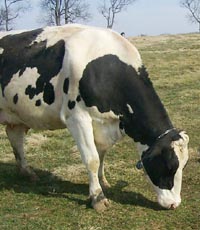Dairy Farmers Can Set Selection Standards for Genetic Improvement
Dairy Farmers Can Set Selection Standards for Genetic Improvement

Genetic improvement is the goal of genetic selection in any population. In the United States, dairy farmers identify milk production as the primary selection trait and genetic selections can have a significant impact on their herd, as well as herds across the country.
“As genetic improvement is taking place in our dairy population, the younger animals should generally be genetically superior to older animals,” said Jack McAllister, University of Kentucky College of Agriculture Extension dairy specialist. “This situation is being taken into account in our national cow and bull genetic evaluation system.”
Genetic evaluations of animals are produced four times each year. McAllister said that since genetic improvement is continuing, an animal’s genetic evaluation actually can decrease over time because of the increasing quality of new animals.
“In fact, to account for genetic change, the genetic base for evaluations is updated every five years,” he said. “It was done last in 2000 and will be done again in 2005.”
Dairy farmers can make the greatest genetic impact on their herd by purchasing bull semen they will use to artificially inseminate cows and heifers that will produce the next generation of females. Semen purchased from specific artificial-insemination businesses will have genetic evaluations for several production and non-production traits individually as well as indices of lifetime genetic merit, which combine a number of traits.
“When the genetic evaluations for these bulls are calculated, the bulls are ranked from top to bottom and levels for individual percents from zero to 100 are determined,” McAllister said. “So the level for the 80 percentile indicates that 80 percent of the population is at or below that level and 20 percent is above.”
McAllister said the percentile ranking is an excellent tool to rank bulls and account for changes in rank over time, due to genetic improvement in the population.
The U.S. Department of Agriculture publishes quarterly percentile tables on their Animal Improvement Programs Laboratory Web site. The data include bulls and cows for the Lifetime Net Merit $ index and Lifetime Merit Indices for bulls which emphasize fluid milk production value and cheese production value.
“Using these tables to set standards for selecting AI bulls for your herd can insure that bulls of the desirable genetic level can be identified even as genetic improvement in the population of AI sires has taken place,” McAllister said.
The tables also can be obtained from local county Extension offices.
